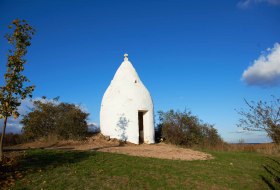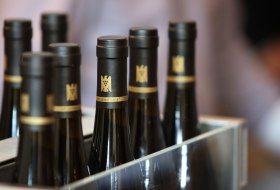
searchMenu



The solid residue in the pressing of fresh grapes. It is composed of grape skins, seeds and stems. From pulp, only pomace brandy (equivalent to the Italian Grappa and the French Marc) may be made, but no wine.

Wine is very temperature sensitive. The right drinking temperature is a prerequisite for the aroma of the wine for the nose (flower) and the palate (bouquet) to unfold properly, not too one sided and intense (too warm), but not too restrained and inexpressive (too cold) either. White wine and rosé wine / Weißherbst are best enjoyed at 10-12°C, red wines at 13-16°C, red wines rich in alcohol and tannins can even be served warmer (up to 18 ° C). These should be decanted before and brought to room temperature.

German expression wor a dry wine. One of the four flavours allowed to be given on Geran wine labels. A wine, that is declared as "trocken" must either have a maximum of 4g/l of residual sugar (which would then be called "klassisch trocken" - classic dry), or a maximum of 9g/l of residual sgar, if the tartaric aid is amaximum of 2g lower tha the residual sugar (e.g. at 8g/l residual sugar may not be less than 6g/l acidity). For sparkling wine, however, the term "trocken" indicates a residual sugar content of between 17 and 35 g…

Predicate for a quality wine that meets certain requirements for the quality of the grapes and must weight. In addition to the requirements that every quality wine must meet with predicate, only extensively shrunken, noble rot berries may be used. The minimum must weight must be 150 ° Oechsle for all grape varieties.

A Trollschoppe is the last "Schoppe" one drinks before going home.

Also called lees or bottoms; remains of the grapes, like the skin or the pulp, that are in the wine. But also residues (dead yeast cultures) after fermentation. Most of the deposit is filtered out through the filtration , so that in the final product it is no longer available.

Little house in the vineyards, where workers used to seek shelter from rain or have their lunch, plural = trulli

Registered association based in Mainz, abbreviation VDP. Identification mark for wines of members of the VDP since the year 1991 the VDP capsule with the "grape eagle". The statutes of the VDP contain strict quality criteria such as voluntary yield restrictions or higher than the prescribed minimum must weights. Integrated viticulture as a minimum standard. In Rheinhessen, the association currently has 16 member companies (VDP Rheinhessen).

Mixture of wines of different vintages, grape varieties and origins. Blends require great practical experience of the cellar master and are a real art. Blends are often misunderstood and connected with wine fraud. However, the blend is generally restricted by law, so that information on vintage, grape varieties and origin need to be given.

Vinissima is a nationwide, job-related and cross-generational network for women who work as winegrowers, enologists, women scientists, wine merchants, restaurateurs, sommeliers, journalists or in wine marketing. The network was founded in 1991 by seven women and today has up to 500 members. Link to the Vinissima homepage